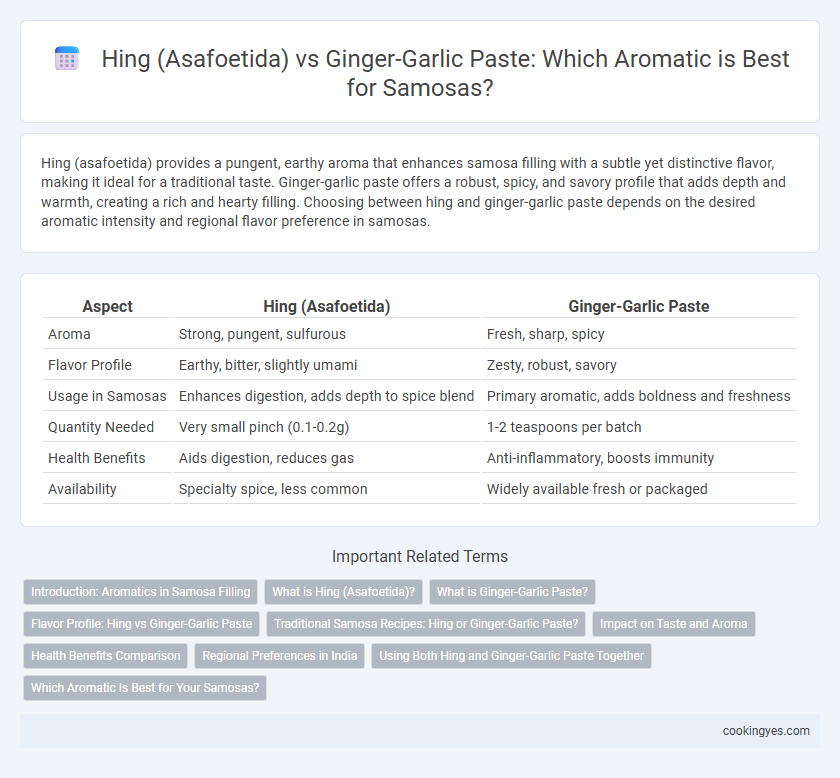Hing (asafoetida) provides a pungent, earthy aroma that enhances samosa filling with a subtle yet distinctive flavor, making it ideal for a traditional taste. Ginger-garlic paste offers a robust, spicy, and savory profile that adds depth and warmth, creating a rich and hearty filling. Choosing between hing and ginger-garlic paste depends on the desired aromatic intensity and regional flavor preference in samosas.
Table of Comparison
| Aspect | Hing (Asafoetida) | Ginger-Garlic Paste |
|---|---|---|
| Aroma | Strong, pungent, sulfurous | Fresh, sharp, spicy |
| Flavor Profile | Earthy, bitter, slightly umami | Zesty, robust, savory |
| Usage in Samosas | Enhances digestion, adds depth to spice blend | Primary aromatic, adds boldness and freshness |
| Quantity Needed | Very small pinch (0.1-0.2g) | 1-2 teaspoons per batch |
| Health Benefits | Aids digestion, reduces gas | Anti-inflammatory, boosts immunity |
| Availability | Specialty spice, less common | Widely available fresh or packaged |
Introduction: Aromatics in Samosa Filling
Hing (asafoetida) and ginger-garlic paste are key aromatics that significantly influence the flavor profile of samosa filling. Hing imparts a pungent, umami-rich aroma that enhances the savory notes, especially in vegetarian fillings, while ginger-garlic paste adds a warm, spicy depth that complements both vegetarian and meat samosas. Selecting between these aromatics depends on regional preferences and desired intensity, shaping the overall taste experience of this popular snack.
What is Hing (Asafoetida)?
Hing, or asafoetida, is a pungent resin derived from the Ferula plant, commonly used as a digestive aid and flavor enhancer in Indian cuisine. It imparts a distinct sulfurous aroma that mellows into a savory umami flavor when cooked, making it ideal for samosa fillings to add depth without overpowering. Unlike ginger-garlic paste, which provides a spicy and aromatic base, hing offers subtle earthiness and aids in balancing complex spices in samosa masala.
What is Ginger-Garlic Paste?
Ginger-garlic paste is a blend of fresh ginger and garlic ground into a smooth, aromatic paste commonly used in Indian cuisine to enhance flavor and aroma. It adds a pungent, slightly spicy, and savory depth to samosas, complementing the savory filling with its robust taste. Unlike hing (asafoetida), which has a strong, sulfurous aroma and is used sparingly as a digestive aid, ginger-garlic paste provides a fuller, fresher aromatic profile essential for rich, flavorful samosa fillings.
Flavor Profile: Hing vs Ginger-Garlic Paste
Hing (asafoetida) imparts a pungent, slightly sulfurous aroma that enhances samosas with a distinct earthy and umami depth, creating a unique, savory flavor profile often favored in traditional Indian recipes. Ginger-garlic paste delivers a robust, warm, and zesty aroma, contributing sharp, spicy undertones that elevate the overall taste with freshness and mild heat. Choosing between hing and ginger-garlic paste significantly influences the samosa's aromatic complexity, with hing offering subtle bitterness and umami versus ginger-garlic's vibrant, pungent spiciness.
Traditional Samosa Recipes: Hing or Ginger-Garlic Paste?
Traditional samosa recipes often debate the use of hing (asafoetida) versus ginger-garlic paste for aromatic depth. Hing imparts a distinctive pungent flavor that enhances the spice profile without overpowering, ideal for vegetarian samosas or those with lentil fillings. Ginger-garlic paste adds a robust, savory warmth, commonly preferred in meat-filled samosas for its ability to balance heaviness and introduce a fresh zing.
Impact on Taste and Aroma
Hing (asafoetida) imparts a distinct pungent aroma and slightly bitter undertone that enhances the savory depth of samosa filling, creating a unique flavor profile appreciated in traditional Indian cuisines. Ginger-garlic paste contributes a fresh, zesty, and mildly spicy aromatic character, offering complexity and warmth that complements meat or vegetable fillings. The choice between hing and ginger-garlic paste significantly influences the final taste, with hing providing bold earthiness and ginger-garlic paste adding vibrant zest and richness.
Health Benefits Comparison
Hing (asafoetida) offers potent digestive benefits and antimicrobial properties that help reduce bloating and improve gut health when used in samosas. Ginger-garlic paste provides strong anti-inflammatory and immune-boosting effects, supporting cardiovascular health and enhancing flavor depth. Choosing between hing and ginger-garlic paste depends on desired health outcomes, as hing focuses more on digestive wellness while ginger-garlic enhances overall immunity and inflammation control.
Regional Preferences in India
In Indian samosa recipes, regional preferences dictate the choice between hing (asafoetida) and ginger-garlic paste for aromatics, with hing predominantly used in Gujarati cuisine to provide a subtle, pungent flavor that complements lentil fillings. In contrast, North Indian samosas typically incorporate ginger-garlic paste, enhancing depth and warmth in spiced potato or meat fillings. This divergence reflects broader regional culinary practices, where hing is favored in vegetarian dishes of western India, while ginger-garlic paste prevails in the hearty, savory profiles of northern Indian snacks.
Using Both Hing and Ginger-Garlic Paste Together
Using both hing (asafoetida) and ginger-garlic paste in samosa filling enhances the aromatic profile by combining the pungent, earthy notes of hing with the sharp, spicy flavors of ginger and garlic. This blend intensifies the depth of the spices, creating a more complex and savory taste that complements the crispy samosa crust. Incorporating hing alongside ginger-garlic paste also aids digestion, making the filling not only flavorful but easier on the stomach.
Which Aromatic Is Best for Your Samosas?
Hing (asafoetida) imparts a pungent, umami-rich aroma that enhances the traditional Indian flavor profile of samosas, especially in vegetarian fillings like lentils and potatoes. Ginger-garlic paste offers a fresher, spicier, and more robust aroma, ideal for meat-based or mixed vegetable samosas, creating a balanced and savory depth. Choosing between hing and ginger-garlic paste depends on the desired flavor complexity and the type of filling used, with hing favored for subtle, earthy notes and ginger-garlic for bold, vibrant taste.
Hing (asafoetida) vs Ginger-garlic paste for aromatics in samosas Infographic

 cookingyes.com
cookingyes.com